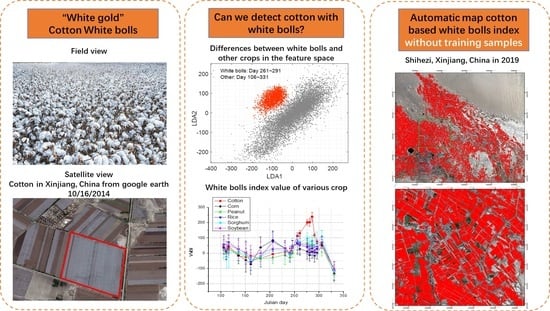Automatic Cotton Mapping Using Time Series of Sentinel-2 Images
Abstract
:1. Introduction
2. Materials and Methods
2.1. Study Sites
2.2. Data Used in the Study
2.2.1. Satellite Images
2.2.2. Ground References
2.3. Method
2.3.1. Temporal and Spectral Conjoint Analysis
2.3.2. Discriminate the Cotton Bolls from Other Crops
2.3.3. Compared with Supervised Classifier
2.3.4. Extract the Start of Bolls Opening Time
3. Results
3.1. Construction of White Bolls Index
3.2. Automatically Mapping the Cotton with White Bolls Index and Accuracy Assessment
3.3. Identification of Bolls Opening Date
4. Discussion
5. Conclusions
Author Contributions
Funding
Institutional Review Board Statement
Informed Consent Statement
Data Availability Statement
Conflicts of Interest
References
- Haider, A.; Bashir, A.; Husnain, M.I.U. Impact of agricultural land use and economic growth on nitrous oxide emissions: Evidence from developed and developing countries. Sci. Total Environ. 2020, 741, 140421. [Google Scholar] [CrossRef] [PubMed]
- Wardropper, C.B.; Mase, A.S.; Qiu, J.; Kohl, P.; Booth, E.G.; Rissman, A.R. Ecological worldview, agricultural or natural resource-based activities, and geography affect perceived importance of ecosystem services. Landsc. Urban Plan. 2020, 197, 103768. [Google Scholar] [CrossRef]
- Vermeulen, S.; Zougmoré, R.; Wollenberg, E.; Thornton, P.; Nelson, G.; Kristjanson, P.; Kinyangi, J.; Jarvis, A.; Hansen, J.; Challinor, A.; et al. Climate change, agriculture and food security: A global partnership to link research and action for low-income agricultural producers and consumers. Curr. Opin. Environ. Sustain. 2012, 4, 128–133. [Google Scholar] [CrossRef] [Green Version]
- Sun, S.; Li, C.; Chee, P.W.; Paterson, A.H.; Jiang, Y.; Xu, R.; Robertson, J.S.; Adhikari, J.; Shehzad, T. Three-dimensional photogrammetric mapping of cotton bolls in situ based on point cloud segmentation and clustering. ISPRS J. Photogramm. Remote Sens. 2020, 160, 195–207. [Google Scholar] [CrossRef]
- Jans, Y.; von Bloh, W.; Schaphoff, S.; Müller, C. Global cotton production under climate change—Implications for yield and water consumption. Hydrol. Earth Syst. Sci. Discuss. 2020, 2020, 1–27. [Google Scholar] [CrossRef] [Green Version]
- Khan, M.A.; Wahid, A.; Ahmad, M.; Tahir, M.T.; Ahmed, M.; Ahmad, S.; Hasanuzzaman, M. World Cotton Production and Consumption: An Overview. In Cotton Production and Uses: Agronomy, Crop Protection, and Postharvest Technologies; Ahmad, S., Hasanuzzaman, M., Eds.; Springer: Singapore, 2020; pp. 1–7. [Google Scholar] [CrossRef]
- Sawan, Z.M. Climatic variables: Evaporation, sunshine, relative humidity, soil and air temperature and its adverse effects on cotton production. Inf. Process. Agric. 2018, 5, 134–148. [Google Scholar] [CrossRef]
- Hao, P.Y.; Zhan, Y.L.; Wang, L.; Niu, Z.; Shakir, M. Feature Selection of Time Series MODIS Data for Early Crop Classification Using Random Forest: A Case Study in Kansas, USA. Remote Sens. 2015, 7, 5347–5369. [Google Scholar] [CrossRef] [Green Version]
- Xiong, J.; Thenkabail, P.S.; Gumma, M.K.; Teluguntla, P.; Poehnelt, J.; Congalton, R.G.; Yadav, K.; Thau, D. Automated cropland mapping of continental Africa using Google Earth Engine cloud computing. ISPRS J. Photogramm. Remote Sens. 2017, 126, 225–244. [Google Scholar] [CrossRef] [Green Version]
- Gupta, S.; Rajan, K.S. Extraction of training samples from time-series MODIS imagery and its utility for land cover classification. Int. J. Remote Sens. 2011, 32, 9397–9413. [Google Scholar] [CrossRef]
- Estel, S.; Kuemmerle, T.; Alcántara, C.; Levers, C.; Prishchepov, A.; Hostert, P. Mapping farmland abandonment and recultivation across Europe using MODIS NDVI time series. Remote Sens. Environ. 2015, 163, 312–325. [Google Scholar] [CrossRef]
- Peña, M.A.; Brenning, A. Assessing fruit-tree crop classification from Landsat-8 time series for the Maipo Valley, Chile. Remote Sens. Environ. 2015, 171, 234–244. [Google Scholar] [CrossRef]
- Cai, Y.; Guan, K.; Peng, J.; Wang, S.; Seifert, C.A.; Wardlow, B.; Li, Z. A high-performance and in-season classification system of field-level crop types using time-series Landsat data and a machine learning approach. Remote Sens. Environ. 2018, 210, 35–47. [Google Scholar] [CrossRef]
- Ouzemou, J.-E.; Harti, A.; Lhissou, R.; El Moujahid, A.; Bouch, N.; El Ouazzani, R.; Bachaoui, E.; Ghmari, A.E. Crop type mapping from pansharpened Landsat 8 NDVI data: A case of a highly fragmented and intensive agricultural system. Remote Sens. Appl. Soc. 2018, 11, 94–103. [Google Scholar] [CrossRef]
- Wardlow, B.D.; Egbert, S.L. Large-area crop mapping using time-series MODIS 250 m NDVI data: An assessment for the U.S. Central Great Plains. Remote Sens. Environ. 2008, 112, 1096–1116. [Google Scholar] [CrossRef]
- Zhai, Y.; Qu, Z.; Hao, L. Land Cover Classification Using Integrated Spectral, Temporal, and Spatial Features Derived from Remotely Sensed Images. Remote Sens. 2018, 10, 383. [Google Scholar] [CrossRef] [Green Version]
- Müller, H.; Rufin, P.; Griffiths, P.; Barros Siqueira, A.J.; Hostert, P. Mining dense Landsat time series for separating cropland and pasture in a heterogeneous Brazilian savanna landscape. Remote Sens. Environ. 2015, 156, 490–499. [Google Scholar] [CrossRef] [Green Version]
- Peña, M.A.; Liao, R.; Brenning, A. Using spectrotemporal indices to improve the fruit-tree crop classification accuracy. ISPRS J. Photogramm. Remote Sens. 2017, 128, 158–169. [Google Scholar] [CrossRef]
- Waldner, F.; Canto, G.S.; Defourny, P. Automated annual cropland mapping using knowledge-based temporal features. ISPRS J. Photogramm. Remote Sens. 2015, 110, 1–13. [Google Scholar] [CrossRef]
- Skakun, S.; Franch, B.; Vermote, E.; Roger, J.; Becker-Reshef, I.; Justice, C.; Kussul, N. Early season large-area winter crop mapping using MODIS NDVI data, growing degree days information and a Gaussian mixture model. Remote Sens. Environ. 2017, 195, 244–258. [Google Scholar] [CrossRef]
- Zhong, L.; Gong, P.; Biging, G.S. Efficient corn and soybean mapping with temporal extendability: A multi-year experiment using Landsat imagery. Remote Sens. Environ. 2014, 140, 1–13. [Google Scholar] [CrossRef]
- Shao, Y.; Lunetta, R.S.; Wheeler, B.; Iiames, J.S.; Campbell, J.B. An evaluation of time-series smoothing algorithms for land-cover classifications using MODIS-NDVI multi-temporal data. Remote Sens. Environ. 2016, 174, 258–265. [Google Scholar] [CrossRef]
- Massey, R.; Sankey, T.T.; Congalton, R.G.; Yadav, K.; Thenkabail, P.S.; Ozdogan, M.; Meador, A.J.S. MODIS phenology-derived, multi-year distribution of conterminous US crop types. Remote Sens. Environ. 2017, 198, 490–503. [Google Scholar] [CrossRef]
- Roy, D.P.; Yan, L. Robust Landsat-based crop time series modelling. Remote Sens. Environ. 2018, 238, 110810. [Google Scholar] [CrossRef]
- Zhong, L.; Hu, L.; Zhou, H. Deep learning based multi-temporal crop classification. Remote Sens. Environ. 2019, 221, 430–443. [Google Scholar] [CrossRef]
- Xu, J.; Zhu, Y.; Zhong, R.; Lin, Z.; Xu, J.; Jiang, H.; Huang, J.; Li, H.; Lin, T. DeepCropMapping: A multi-temporal deep learning approach with improved spatial generalizability for dynamic corn and soybean mapping. Remote Sens. Environ. 2020, 247, 111946. [Google Scholar] [CrossRef]
- Yan, Y.; Ryu, Y. Exploring Google Street View with deep learning for crop type mapping. ISPRS J. Photogramm. Remote Sens. 2021, 171, 278–296. [Google Scholar] [CrossRef]
- Zeng, L.; Wardlow, B.D.; Xiang, D.; Hu, S.; Li, D. A review of vegetation phenological metrics extraction using time-series, multispectral satellite data. Remote Sens. Environ. 2020, 237, 111511. [Google Scholar] [CrossRef]
- Ashourloo, D.; Shahrabi, H.S.; Azadbakht, M.; Aghighi, H.; Matkan, A.A.; Radiom, S. A Novel Automatic Method for Alfalfa Mapping Using Time Series of Landsat-8 OLI Data. IEEE J. Sel. Top. Appl. Earth Obs. Remote Sens. 2018, 11, 4478–4487. [Google Scholar] [CrossRef]
- Qiu, B.; Luo, Y.; Tang, Z.; Chen, C.; Lu, D.; Huang, H.; Chen, Y.; Chen, N.; Xu, W. Winter wheat mapping combining variations before and after estimated heading dates. ISPRS J. Photogramm. Remote Sens. 2017, 123, 35–46. [Google Scholar] [CrossRef]
- D’andrimont, R.; Taymans, M.; Lemoine, G.; Ceglar, A.; Yordanov, M.; van der Velde, M. Detecting flowering phenology in oil seed rape parcels with Sentinel-1 and -2 time series. Remote Sens Environ. 2020, 239, 111660. [Google Scholar] [CrossRef]
- Ashourloo, D.; Shahrabi, H.S.; Azadbakht, M.; Aghighi, H.; Nematollahi, H.; Alimohammadi, A.; Matkan, A.A. Automatic canola mapping using time series of sentinel 2 images. ISPRS J. Photogramm. Remote Sens. 2019, 156, 63–76. [Google Scholar] [CrossRef]
- United States Department of Agriculture, National Agriculture Statistics Service. Cotton Phenological Stages. Available online: https://www.nass.usda.gov/Publications/National_Crop_Progress/Terms_and_Definitions/index.php (accessed on 1 March 2021).
- Ali, H.; Afzal, M.N.; Ahmad, F.; Ahmad, S.; Atif, R. Effect of Sowing Dates, Plant Spacing and Nitrogen Application on Growth and Productivity on Cotton Crop. Int. J. Sci. Eng. Res. 2013, 2, 1–6. [Google Scholar]
- Wang, X. Impact and Adaptation of Climate Change on Cotton Phenology, Yield and Fiber Quality in Xinjiang. Ph.D. Thesis, China Agricultural University, Beijing, China, 2015. [Google Scholar]
- Zhao, L.U.; Li, L.I.; Tian, C.; Yan, X.; Wang, J.; Liu, Y. Calculation and analysis of cotton phenology in the Northern of Xinjiang. Arid Land Geogr. 2003, 26, 5. [Google Scholar]
- Belhumeur, P.N.; Hespanha, J.P.; Kriegman, D.J. Eigenfaces vs. Fisherfaces: Recognition Using Class Specific Linear Projection. IEEE Trans. Pattern Anal. Mach. Intell. 1997, 19, 711–720. [Google Scholar] [CrossRef] [Green Version]
- Bruzzone, L.; Chi, M.; Marconcini, M. A Novel Transductive SVM for Semisupervised Classification of Remote-Sensing Images. IEEE Trans. Geosci. Remote Sens. 2006, 44, 3363–3373. [Google Scholar] [CrossRef] [Green Version]
- Kranjčić, N.; Medak, D.; Župan, R.; Rezo, M. Support Vector Machine Accuracy Assessment for Extracting Green Urban Areas in Towns. Remote Sens. 2019, 11, 655. [Google Scholar] [CrossRef] [Green Version]
- Rustowicz, R.M. Crop Classification with Multi-Temporal Satellite Imagery; Stanford University: Stanford, CA, USA, 2019. [Google Scholar]
- Chen, J. A simple method for reconstructing a high-quality NDVI time-series data set based on the Savitzky–Golay filter. Remote Sens. Environ. 2004, 91, 332–344. [Google Scholar] [CrossRef]
- White, M.A.; Thornton, P.E.; Running, S.W. A continental phenology model for monitoring vegetation responses to interannual climatic variability. Glob. Biogeochem. Cycles 1997, 11, 217–234. [Google Scholar] [CrossRef]
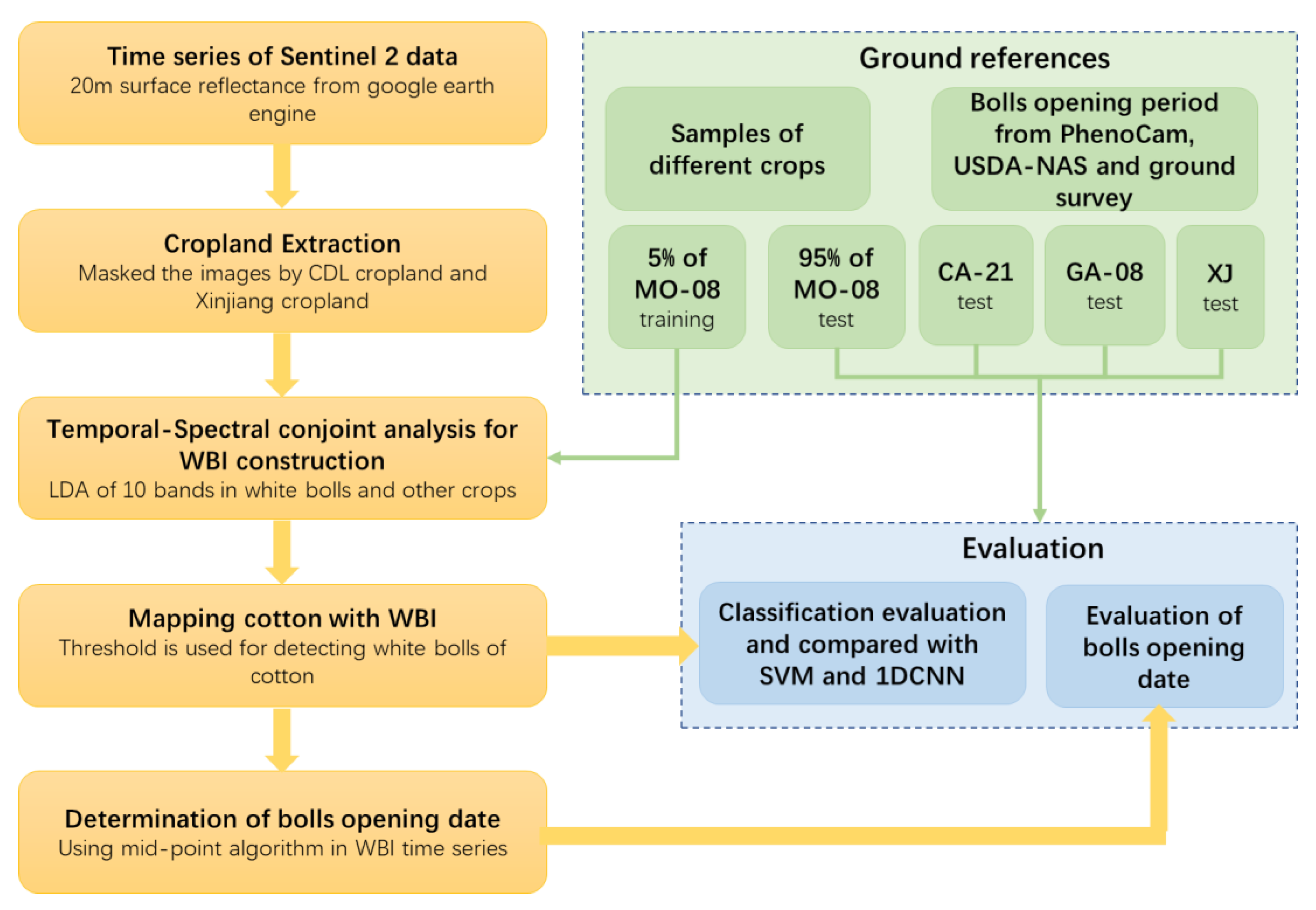
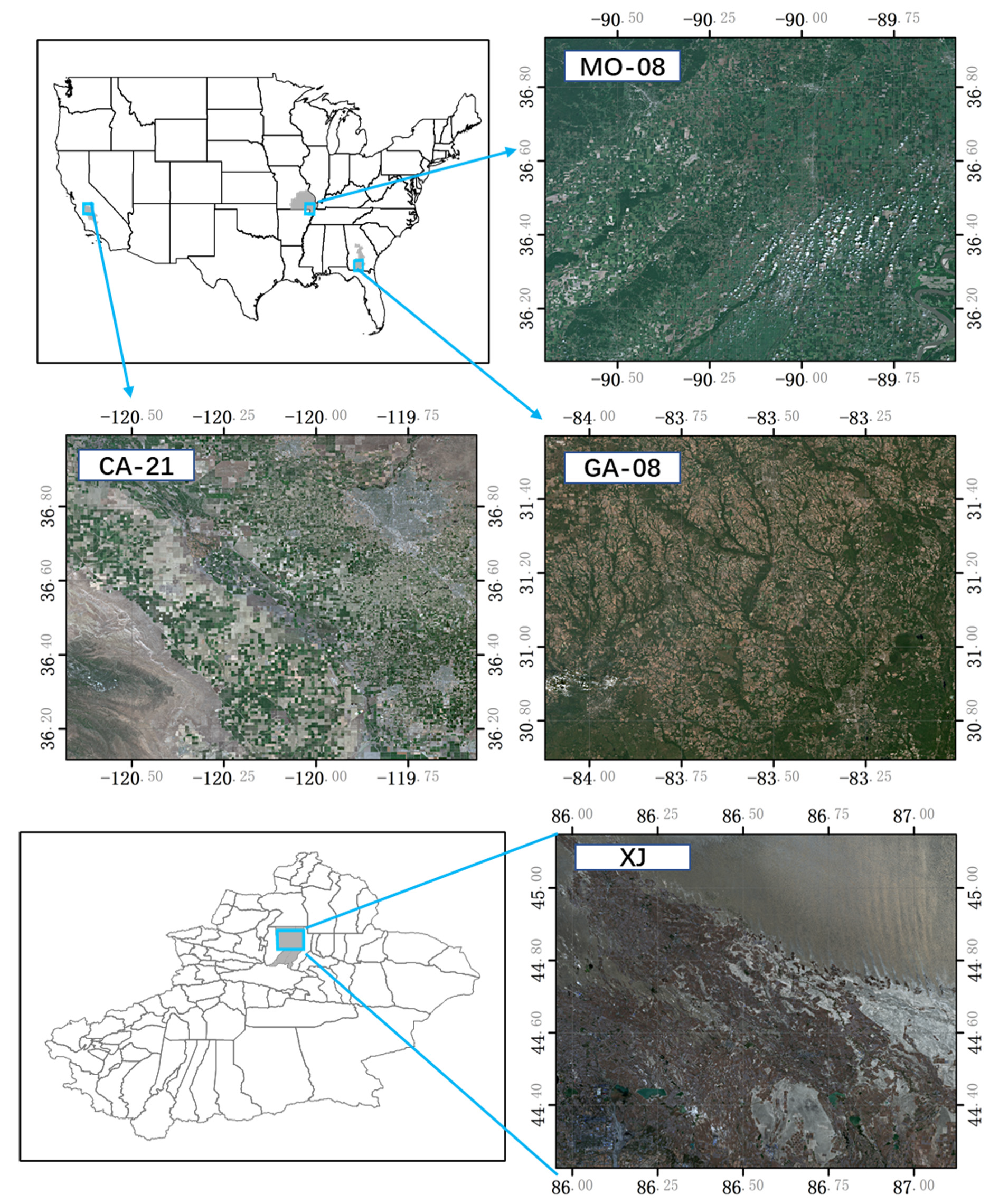
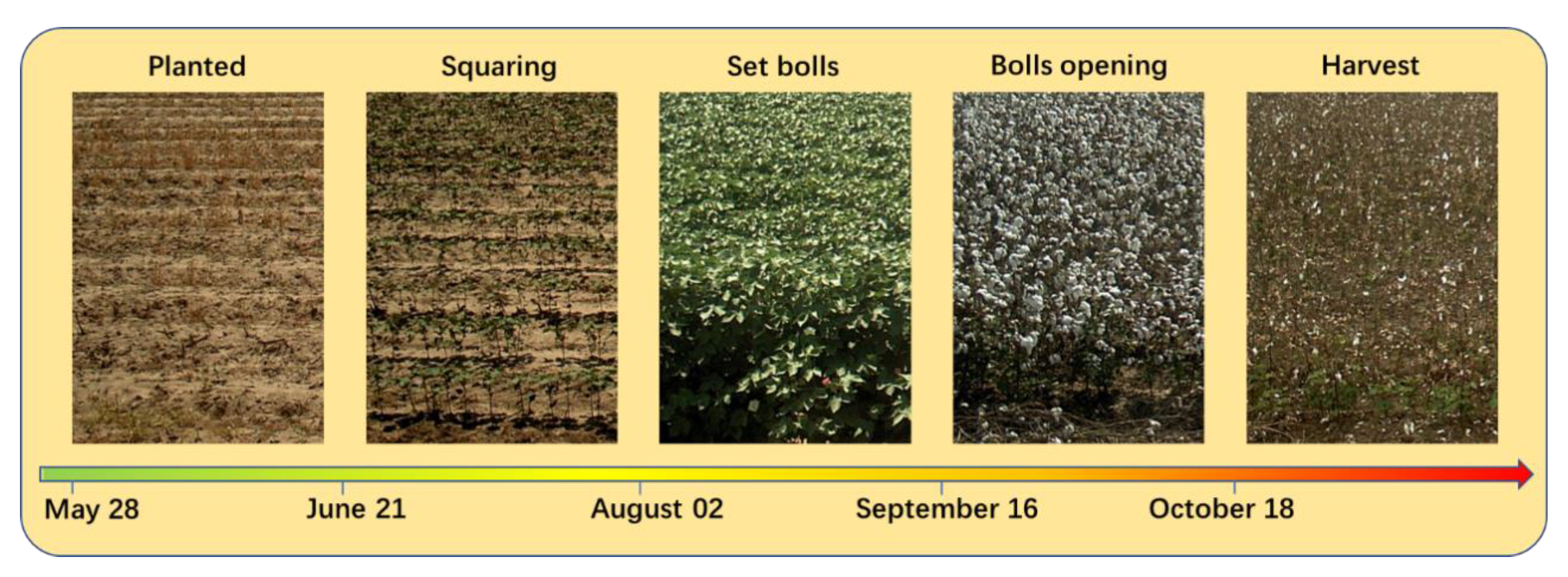
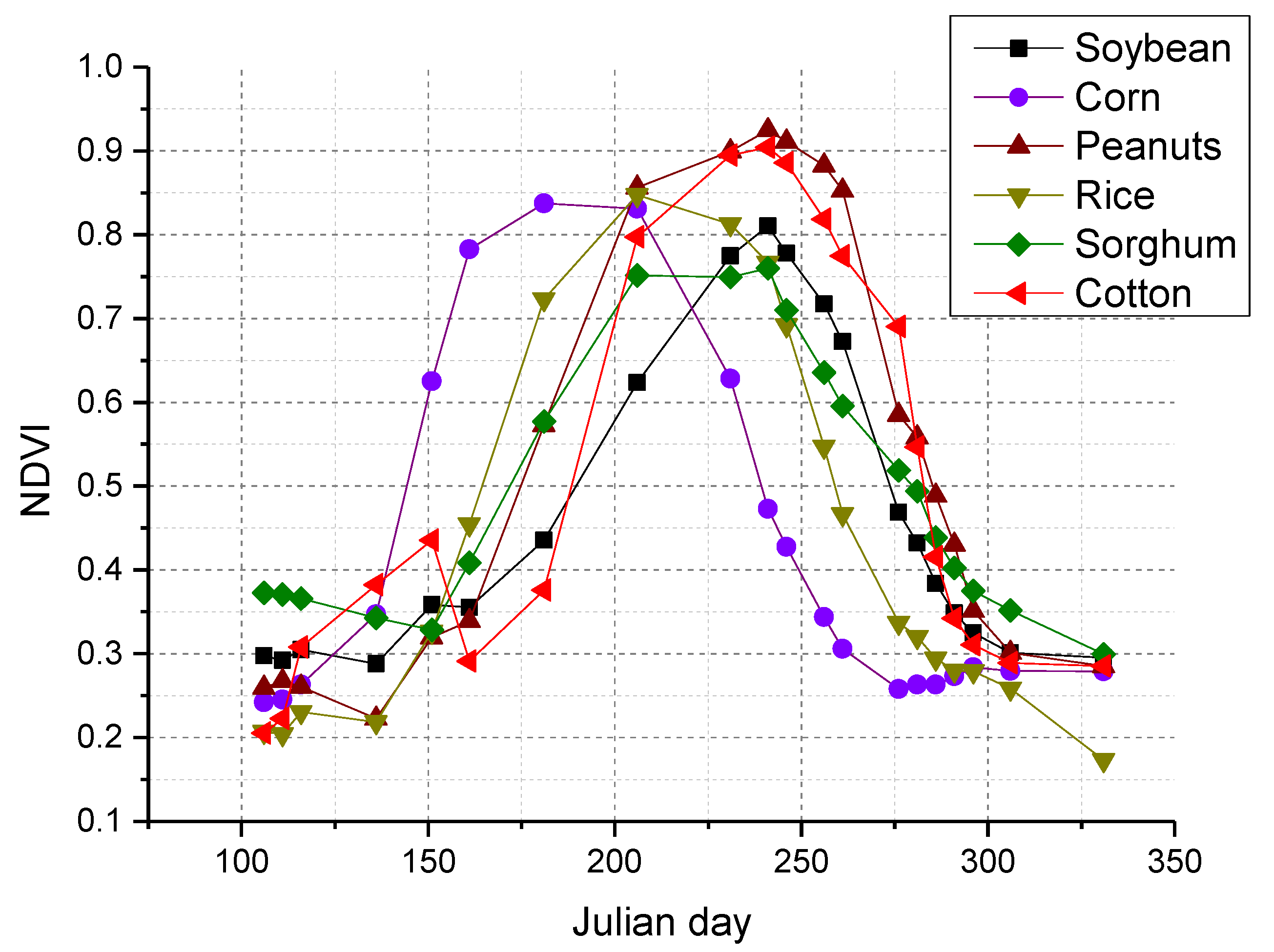

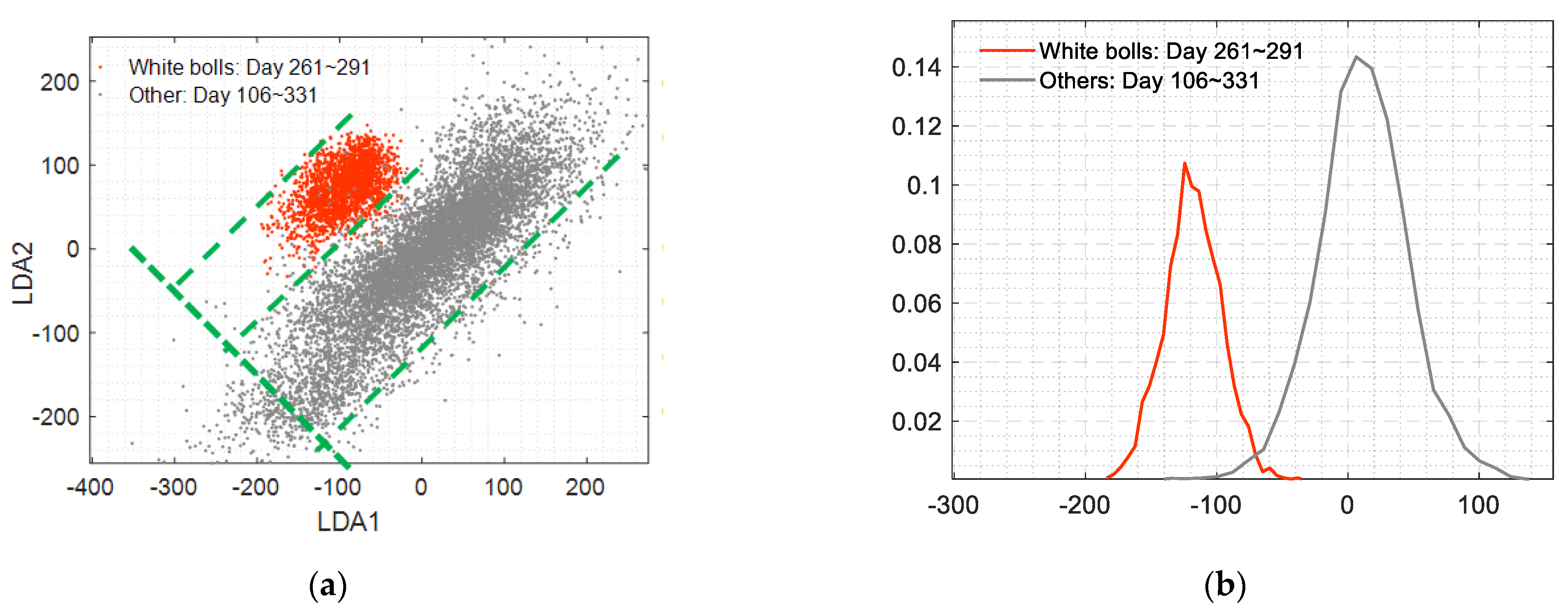
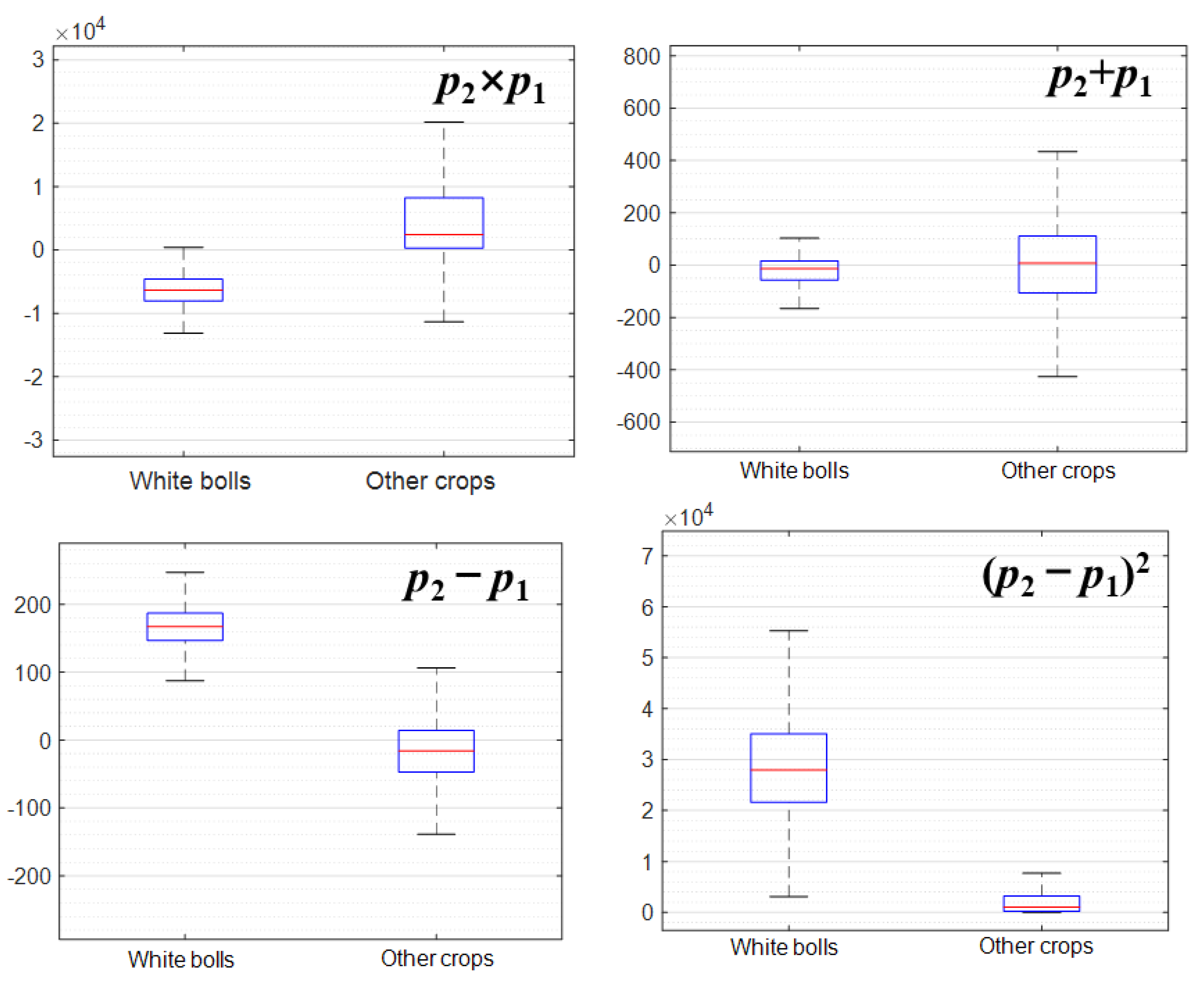
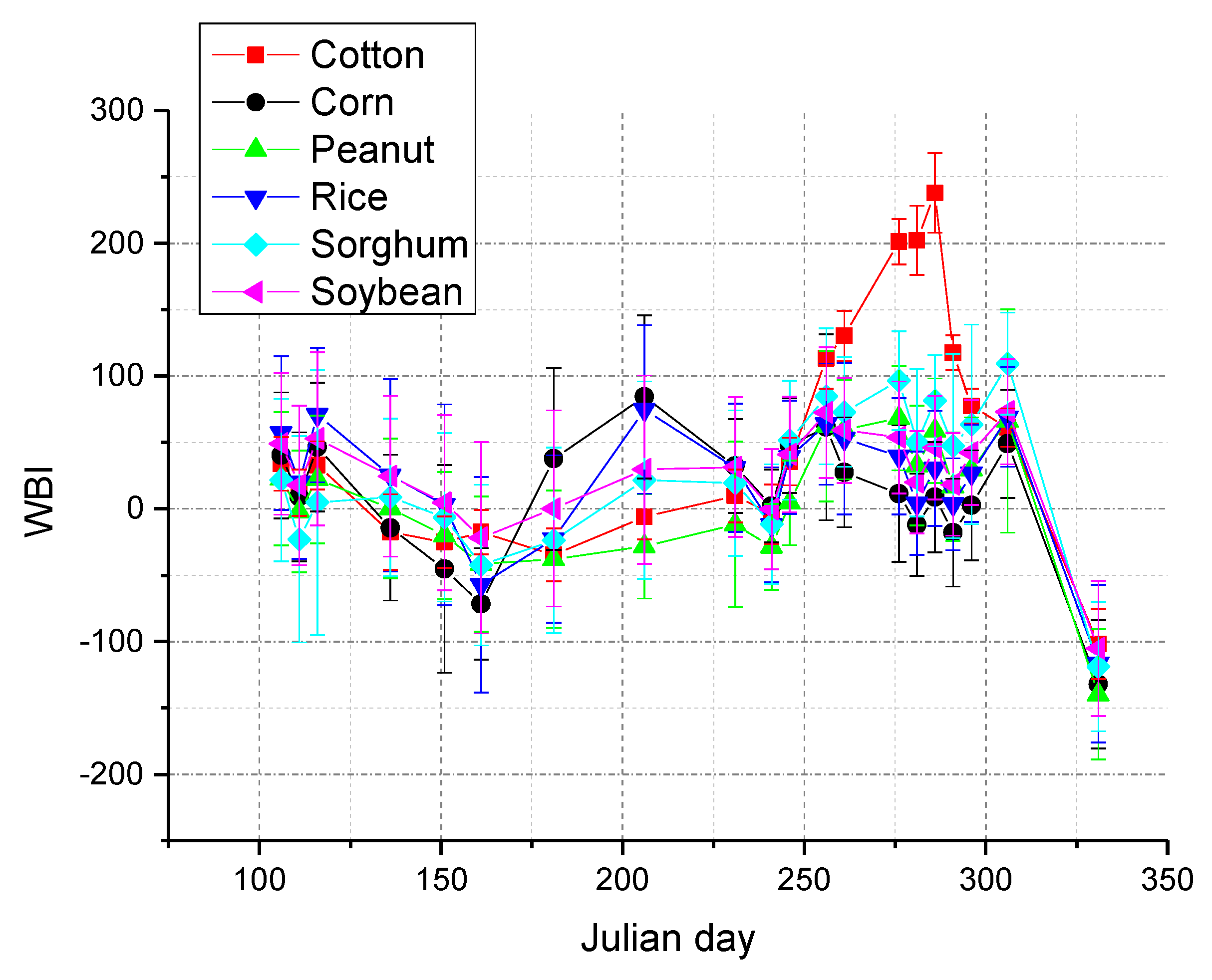
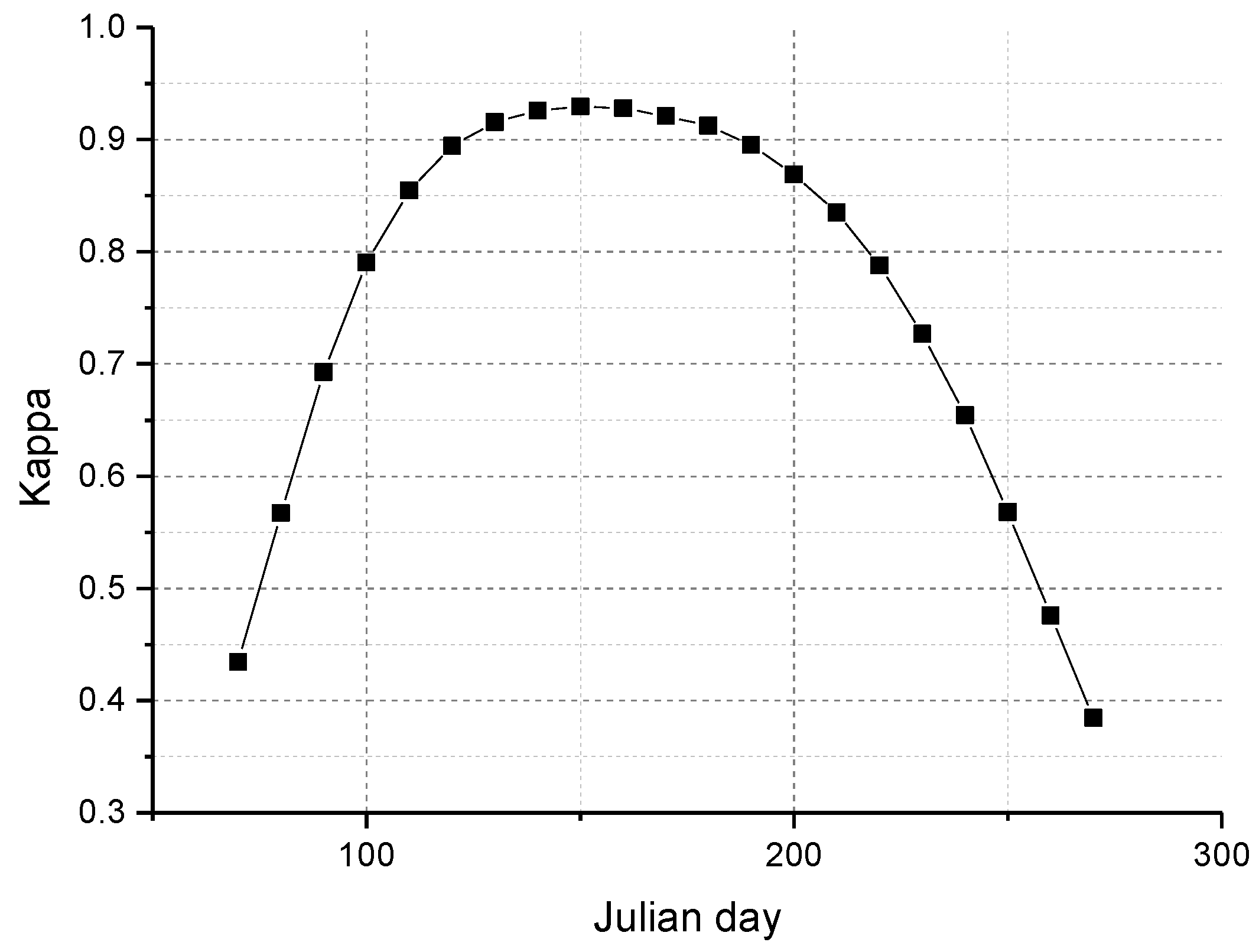
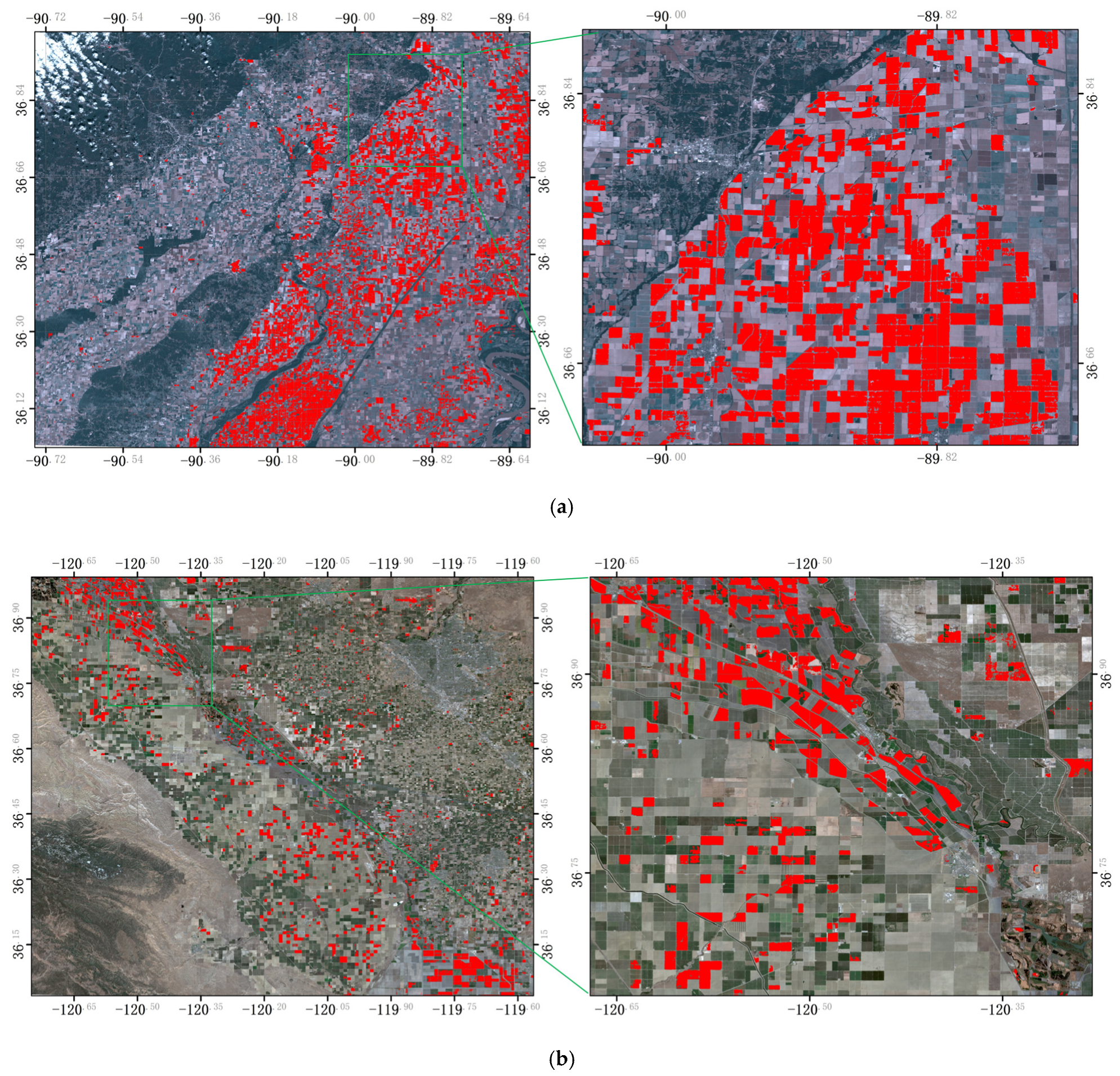

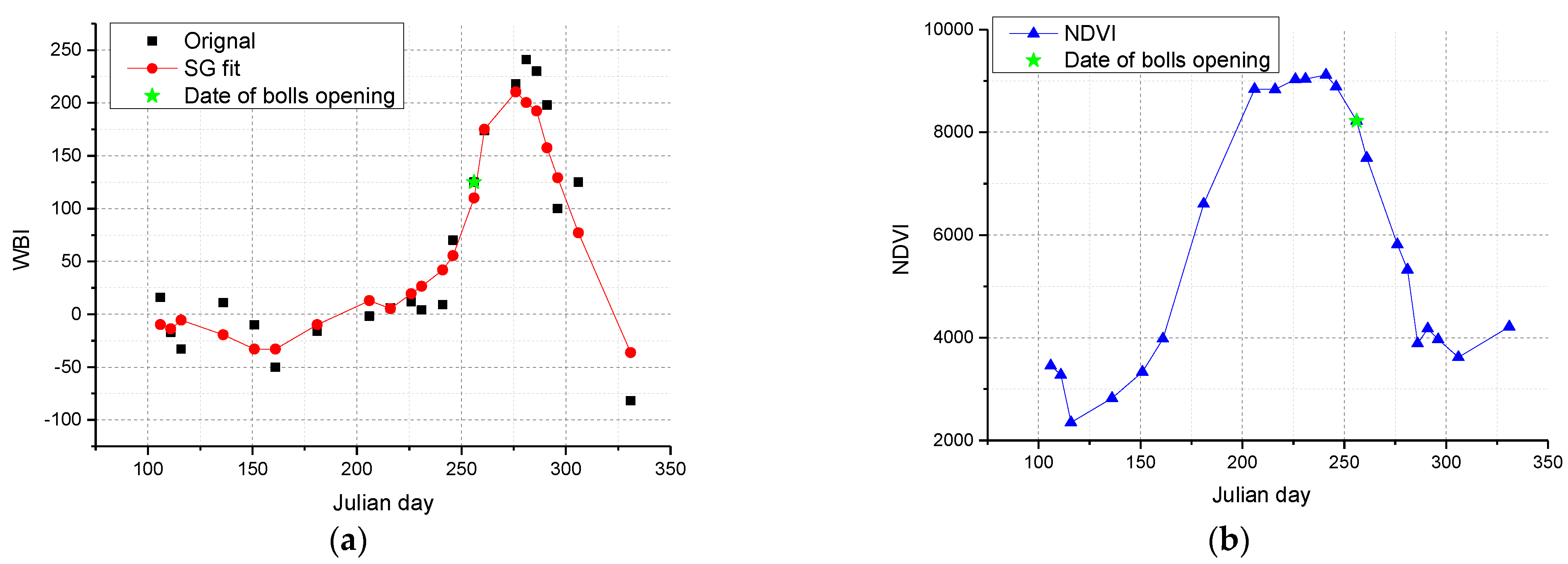
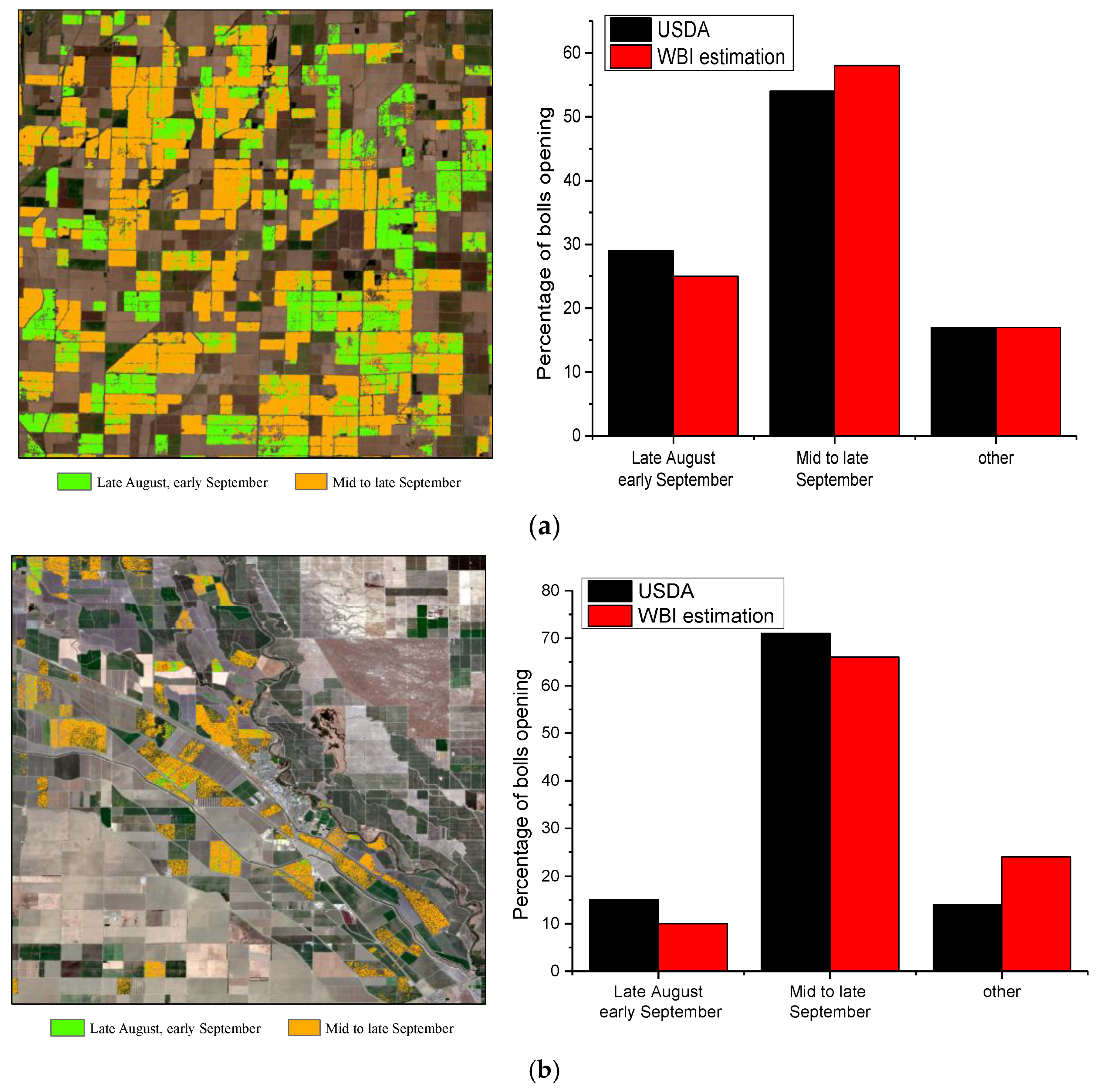
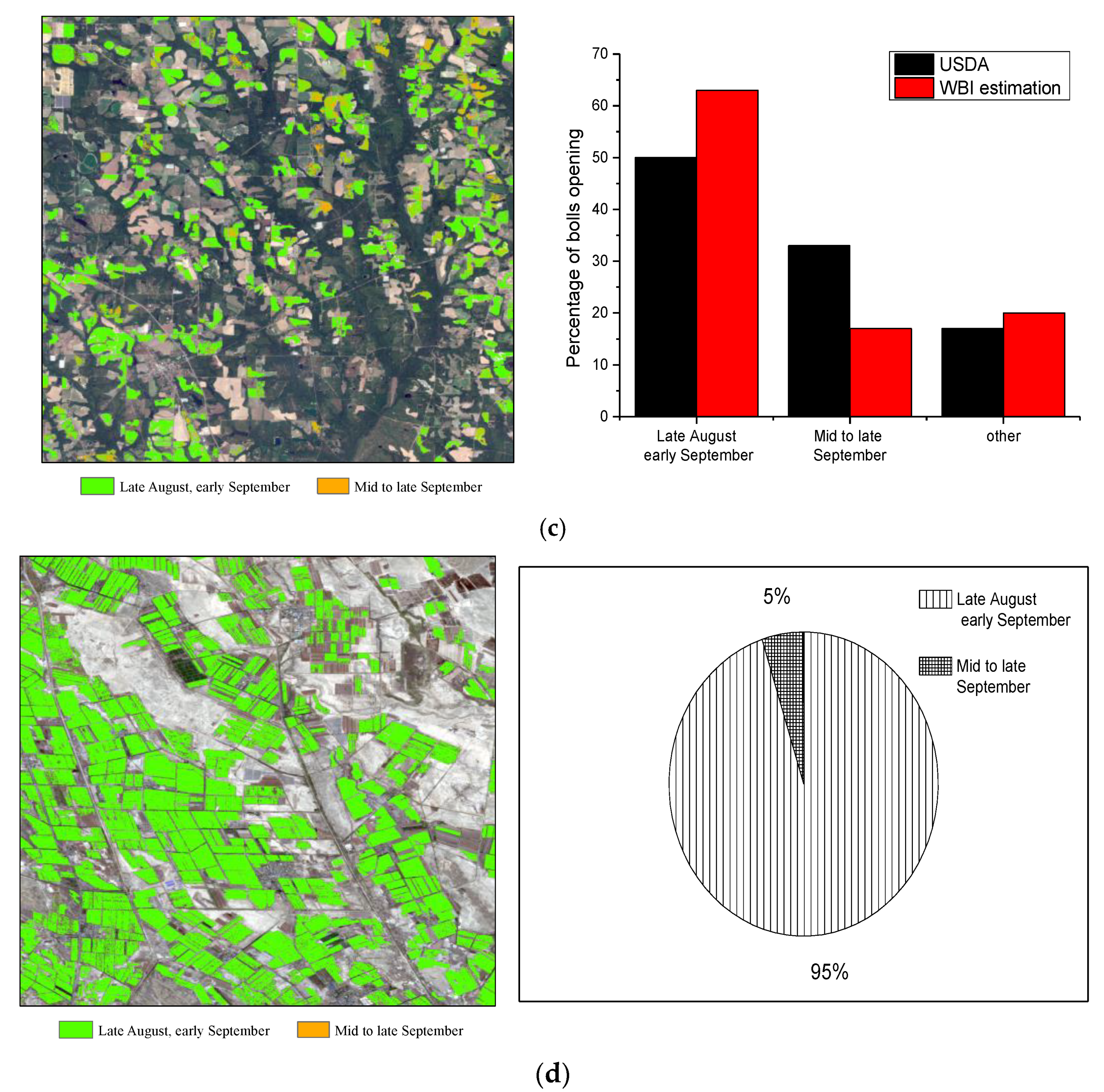
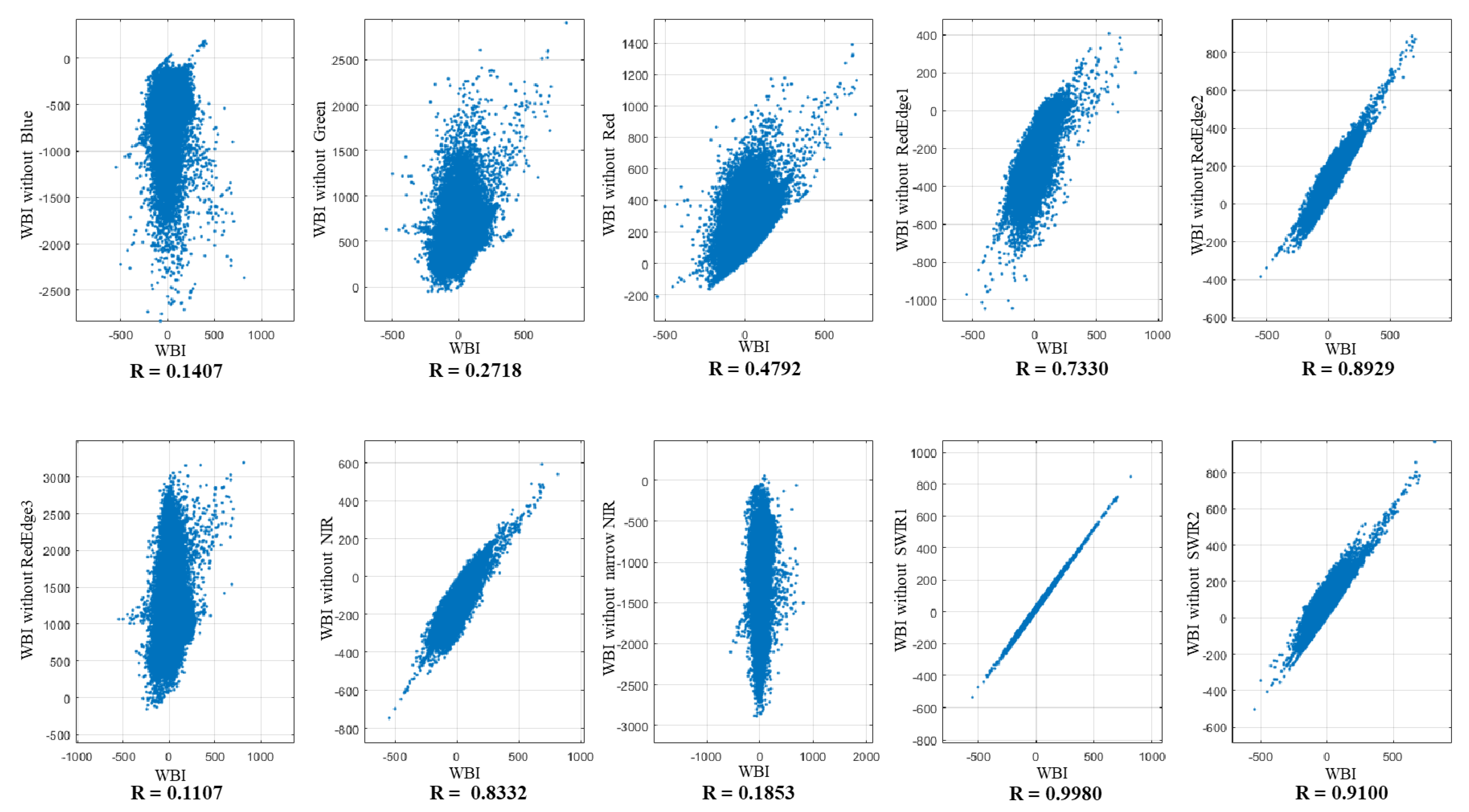
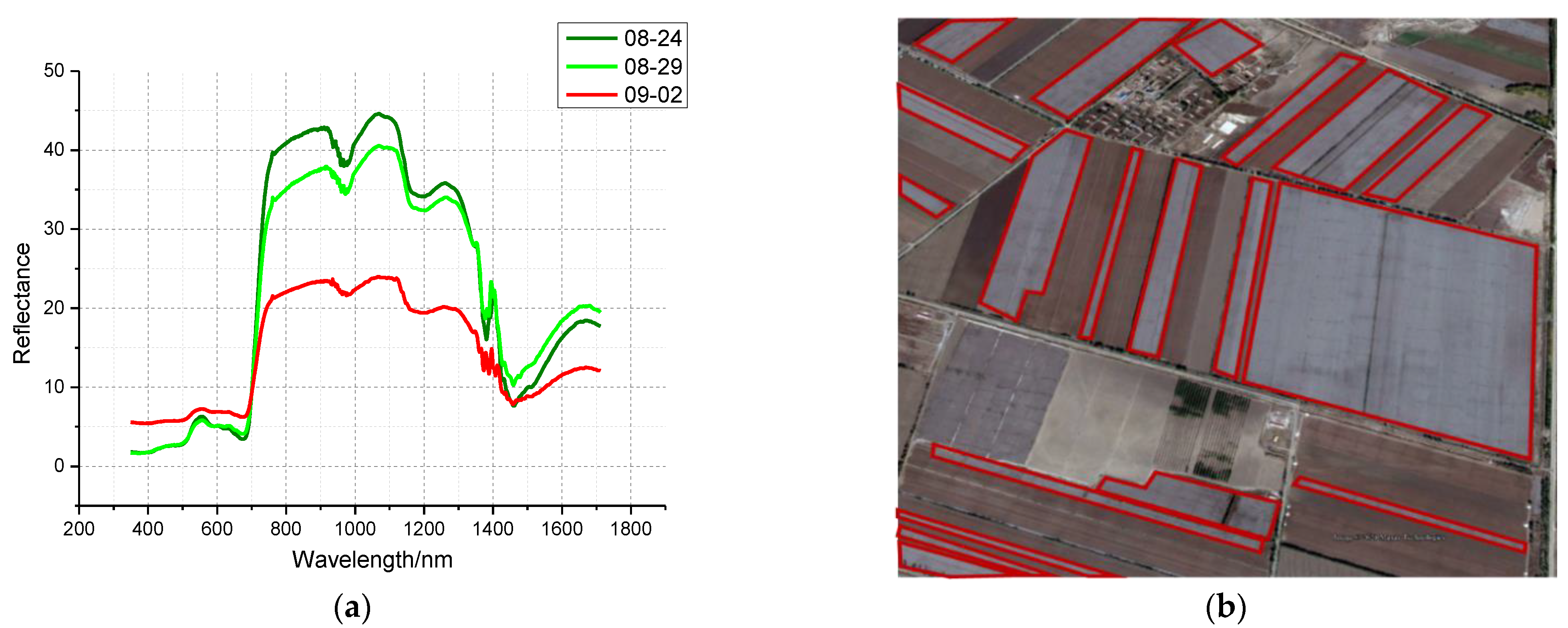
| Region | Elevation (m) | Average Temperature (°C) | Precipitation (mm) | Climate Classification | Major Crop Type | Rank of Cotton in State and U.S. | Major Cotton Type |
|---|---|---|---|---|---|---|---|
| MO-08 | 83 | 15.27 | 1399.03 | Dfa | soybean, cotton, rice, corn | 1/10 | Upland |
| CA-21 | 32 | 15.05 | 489.20 | Csb | almonds, grapes, cotton, pistachios | 1/4 | PIMA |
| GA-08 | 60 | 19.88 | 1492.50 | Cfa | cotton, peanuts, corn | 2/9 | Upland |
| XJ | 347 | 7.41 | 221.44 | BWk | cotton, wheat, corn | -- | Upland |
| Region | Year | Tile NO. | Julian Days |
|---|---|---|---|
| MO-08 | 2019 | 15SYA | 106 111 116 136 151 161 181 206 231 241 246 256 261 276 281 286 291 296 306 331 |
| CA-21 | 2019 | 10SGF | 97 102 107 112 122 127 132 152 157 167 172 177 182 187 192 197 202 207 212 222 227 232 237 242 247 252 257 262 267 272 277 282 287 297 302 307 312 322 327 |
| GA-08 | 2019 | 17RKQ | 112 117 127 147 242 262 267 277 307 317 332 |
| XJ | 2019 | 45TVK | 104 129 149 159 164 179 184 199 209 214 219 224 239 244 254 264 279 284 289 299 304 309 |
| Crop Name | MO-08 | CA-21 | GA-08 | XJ | |||||
|---|---|---|---|---|---|---|---|---|---|
| Training | Test | Training | Test | Training | Test | Training | Test | ||
| Cotton | Cotton | 12 | 227 | 0 | 159 | 0 | 159 | 0 | 122 |
| Other crops | Soybean | 12 | 232 | -- | -- | -- | -- | 0 | 97 |
| Corn | 9 | 178 | 0 | 59 | 0 | 39 | |||
| Rice | 8 | 144 | 0 | 57 | -- | -- | |||
| Peanuts | 3 | 26 | 0 | 44 | 0 | 42 | |||
| Fruit trees | -- | -- | 0 | 415 | -- | -- | |||
| Pecans | -- | -- | -- | -- | 0 | 14 | |||
| Study Site | SVM | 1DCNN | WBI | |||
|---|---|---|---|---|---|---|
| OA | Kappa | OA | Kappa | OA | Kappa | |
| MO-08 | 0.99 | 0.98 | 0.99 | 0.99 | 0.97 | 0.92 |
| CA-21 | 0.83 | 0.56 | 0.76 | 0.16 | 0.90 | 0.74 |
| GA-08 | 0.70 | 0.43 | 0.41 | 0.01 | 0.83 | 0.67 |
| XJ | 0.59 | 0.29 | 0.27 | 0.10 | 0.95 | 0.88 |
Publisher’s Note: MDPI stays neutral with regard to jurisdictional claims in published maps and institutional affiliations. |
© 2021 by the authors. Licensee MDPI, Basel, Switzerland. This article is an open access article distributed under the terms and conditions of the Creative Commons Attribution (CC BY) license (https://creativecommons.org/licenses/by/4.0/).
Share and Cite
Wang, N.; Zhai, Y.; Zhang, L. Automatic Cotton Mapping Using Time Series of Sentinel-2 Images. Remote Sens. 2021, 13, 1355. https://doi.org/10.3390/rs13071355
Wang N, Zhai Y, Zhang L. Automatic Cotton Mapping Using Time Series of Sentinel-2 Images. Remote Sensing. 2021; 13(7):1355. https://doi.org/10.3390/rs13071355
Chicago/Turabian StyleWang, Nan, Yongguang Zhai, and Lifu Zhang. 2021. "Automatic Cotton Mapping Using Time Series of Sentinel-2 Images" Remote Sensing 13, no. 7: 1355. https://doi.org/10.3390/rs13071355





